Self-publishing can be a rewarding venture, but it often comes with financial challenges, especially for authors on a shoestring budget. By identifying essential costs, setting a realistic budget, and prioritizing spending, authors can effectively manage their finances while still producing quality work. Additionally, leveraging cost-effective marketing strategies and utilizing free tools can help promote their books without breaking the bank.
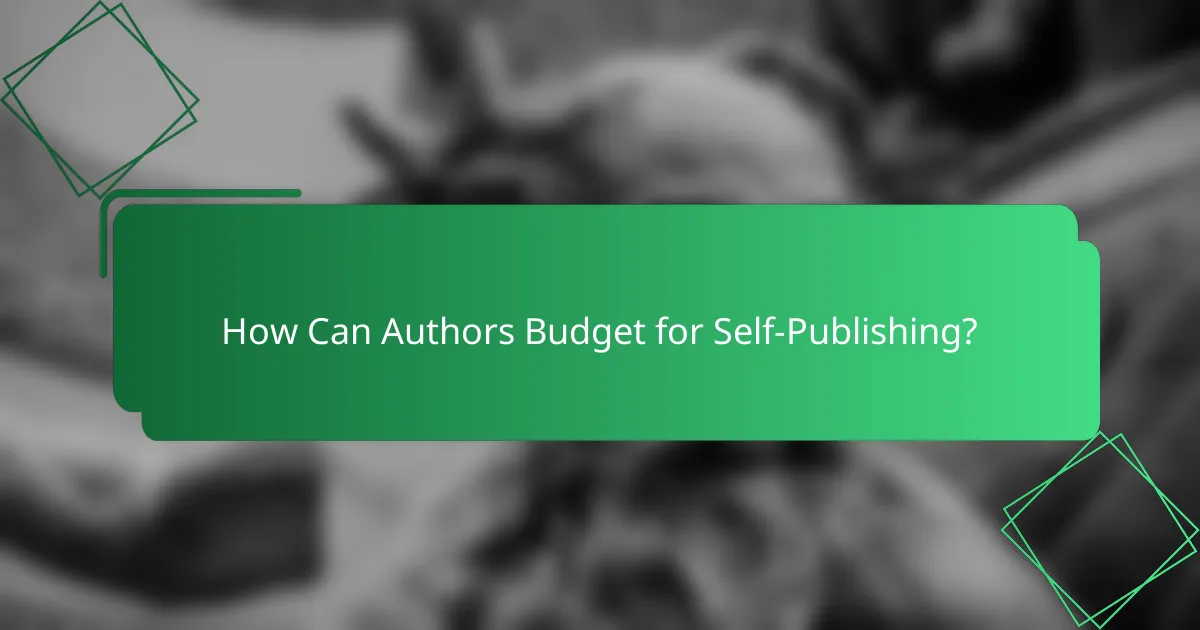
How Can Authors Budget for Self-Publishing?
Authors can budget for self-publishing by identifying essential costs, setting a realistic budget, prioritizing spending, and tracking expenses effectively. These steps help ensure that authors can manage their finances while producing quality work without overspending.
Identify essential costs
To budget effectively, authors must first identify the essential costs associated with self-publishing. Key expenses typically include editing, cover design, formatting, and marketing. Depending on the project, these costs can range from a few hundred to several thousand dollars.
Consider creating a checklist of necessary services and their estimated costs. This will provide a clearer picture of the financial commitment required for your book. Researching industry standards can help you gauge what to expect for each service.
Set a realistic budget
Once you have identified essential costs, set a realistic budget that reflects your financial situation and goals. A good starting point is to allocate funds based on the importance of each service. For instance, if editing is crucial, consider dedicating a larger portion of your budget to that area.
It’s wise to include a buffer of around 10-20% for unexpected expenses. This flexibility can prevent financial strain and allow for adjustments as needed throughout the self-publishing process.
Prioritize spending
Prioritizing spending is essential for authors on a shoestring budget. Determine which elements of self-publishing are most critical to your book’s success. For example, investing in professional editing may take precedence over elaborate marketing campaigns.
Consider a tiered approach to your budget, where you allocate funds to the most impactful areas first. This strategy ensures that your book maintains quality while allowing for gradual investment in other aspects as funds become available.
Track expenses effectively
To stay within budget, tracking expenses effectively is crucial. Use spreadsheets or budgeting apps to monitor your spending in real-time. This practice helps you identify areas where you might be overspending and allows for timely adjustments.
Regularly review your budget against actual expenses to maintain control over your finances. Setting monthly or bi-weekly check-ins can help you stay accountable and ensure that you are on track to meet your self-publishing goals.

What Are Cost-Effective Marketing Strategies?
Cost-effective marketing strategies are budget-friendly approaches that authors can use to promote their books without significant financial investment. These strategies leverage existing platforms and community engagement to reach potential readers effectively.
Utilize social media platforms
Social media platforms like Facebook, Instagram, and Twitter are powerful tools for authors to connect with their audience. Create engaging content that showcases your book, such as behind-the-scenes insights, character spotlights, or reader polls.
Consider joining relevant groups or communities where your target readers gather. Regularly interact with followers to build relationships, which can lead to organic sharing and increased visibility for your work.
Leverage email marketing
Email marketing is an effective way to maintain direct communication with your readers. Start by building an email list through your website or social media, offering incentives like free chapters or exclusive content to encourage sign-ups.
Send regular newsletters that include updates about your writing process, upcoming releases, and special promotions. Aim for a balance between informative content and promotional material to keep your audience engaged without overwhelming them.
Engage in community events
Participating in local community events can significantly boost your visibility as an author. Look for book fairs, local readings, or writing workshops where you can showcase your work and connect with potential readers face-to-face.
Consider organizing your own events, such as book signings or discussion panels, to foster a sense of community around your writing. Collaborating with local bookstores or libraries can also help you reach a wider audience without incurring high costs.
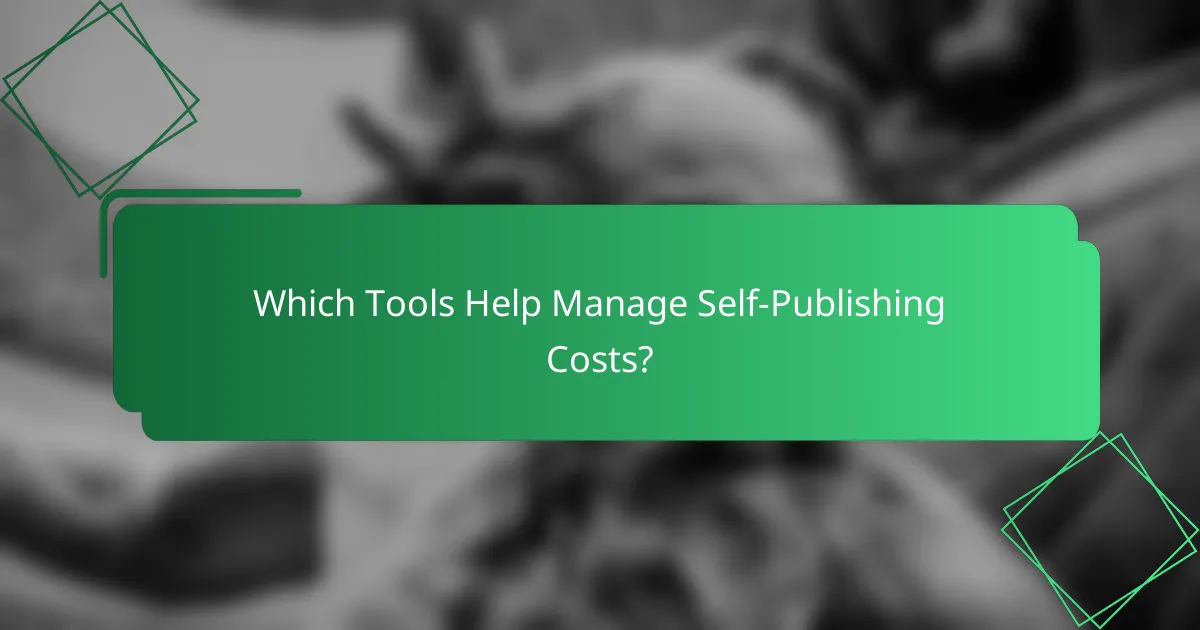
Which Tools Help Manage Self-Publishing Costs?
Managing self-publishing costs effectively requires the right tools to track expenses, design materials, and handle printing. Utilizing budgeting software, free design tools, and print-on-demand services can significantly reduce financial strain while maximizing quality.
Use budgeting software
Budgeting software helps authors keep track of their self-publishing expenses, ensuring they stay within their financial limits. Tools like Mint, YNAB (You Need A Budget), and Excel spreadsheets allow you to categorize costs, set spending limits, and monitor progress over time.
When selecting budgeting software, consider ease of use and features that suit your needs. Look for options that allow for expense tracking, income forecasting, and reporting. Regularly updating your budget can help identify areas where you can cut costs or reallocate funds effectively.
Explore free design tools
Free design tools can help authors create professional-looking book covers and marketing materials without incurring high costs. Platforms like Canva, GIMP, and Adobe Spark offer user-friendly interfaces and templates tailored for book design.
While using free design tools, focus on maintaining a consistent brand image across all your materials. Take advantage of online tutorials to enhance your design skills, and always seek feedback from peers to ensure your visuals resonate with your target audience.
Consider print-on-demand services
Print-on-demand (POD) services allow authors to print copies of their books as orders come in, eliminating the need for large upfront printing costs. Companies like Amazon KDP, IngramSpark, and Lulu offer flexible options for authors looking to minimize financial risk.
When choosing a POD service, compare printing costs, distribution options, and royalty structures. It’s essential to understand the quality of printing and binding offered, as well as the potential reach of your book through various retail channels. This approach can help you manage costs while still delivering a quality product to readers.
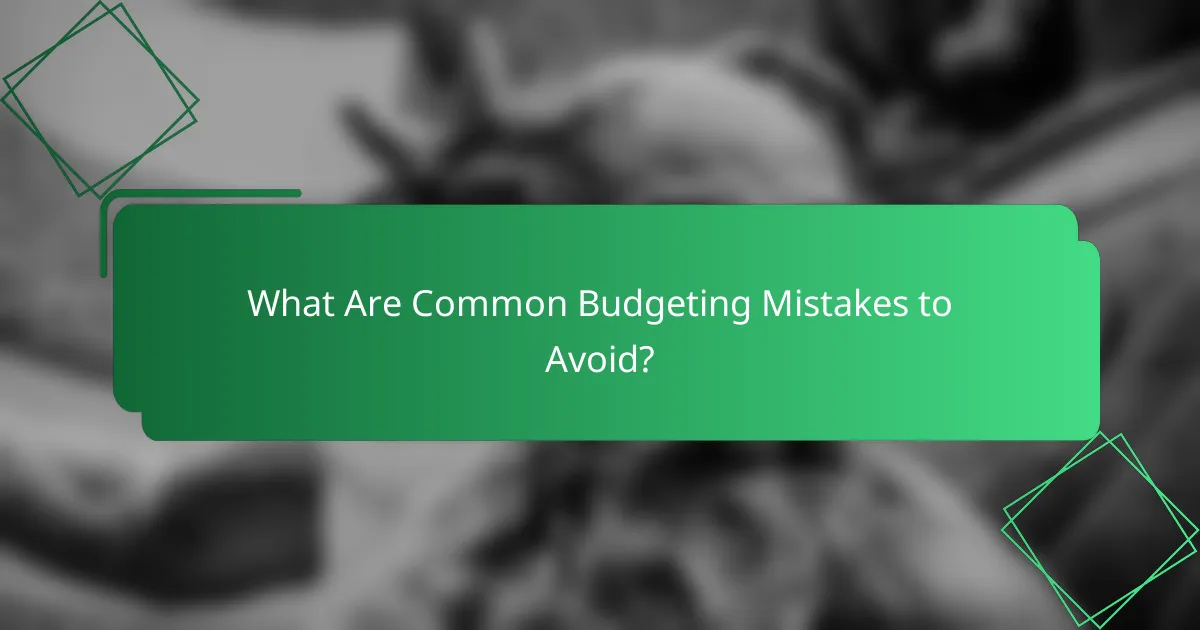
What Are Common Budgeting Mistakes to Avoid?
Authors on a tight budget often make several common mistakes that can derail their self-publishing efforts. Recognizing these pitfalls can help you allocate your funds more effectively and avoid unnecessary expenses.
Overestimating print costs
Many authors assume that print costs will be significantly higher than they actually are. By researching different print-on-demand services, you can find competitive pricing that fits your budget. For instance, costs can vary widely, with some services charging as little as $2 to $5 per book for basic printing.
To avoid overestimating, get quotes from multiple providers and consider factors like page count, binding type, and paper quality. This will help you create a more accurate budget and prevent unexpected expenses.
Neglecting hidden fees
Hidden fees can quickly add up and derail your budget if you’re not careful. Common hidden costs include setup fees, shipping charges, and royalties for distribution platforms. Always read the fine print and ask for a breakdown of all potential costs before committing to a service.
To stay on top of these fees, create a checklist of all possible expenses associated with your self-publishing journey. This proactive approach will help you identify and account for these hidden costs in your overall budget.
Ignoring marketing expenses
Marketing is a crucial aspect of self-publishing that many authors overlook when budgeting. Without a solid marketing plan, even the best books can go unnoticed. Allocate a portion of your budget for marketing efforts, which can range from social media ads to promotional materials.
Consider setting aside at least 10-20% of your total budget for marketing. This investment can significantly enhance your book’s visibility and sales, making it a worthwhile expense in the long run.
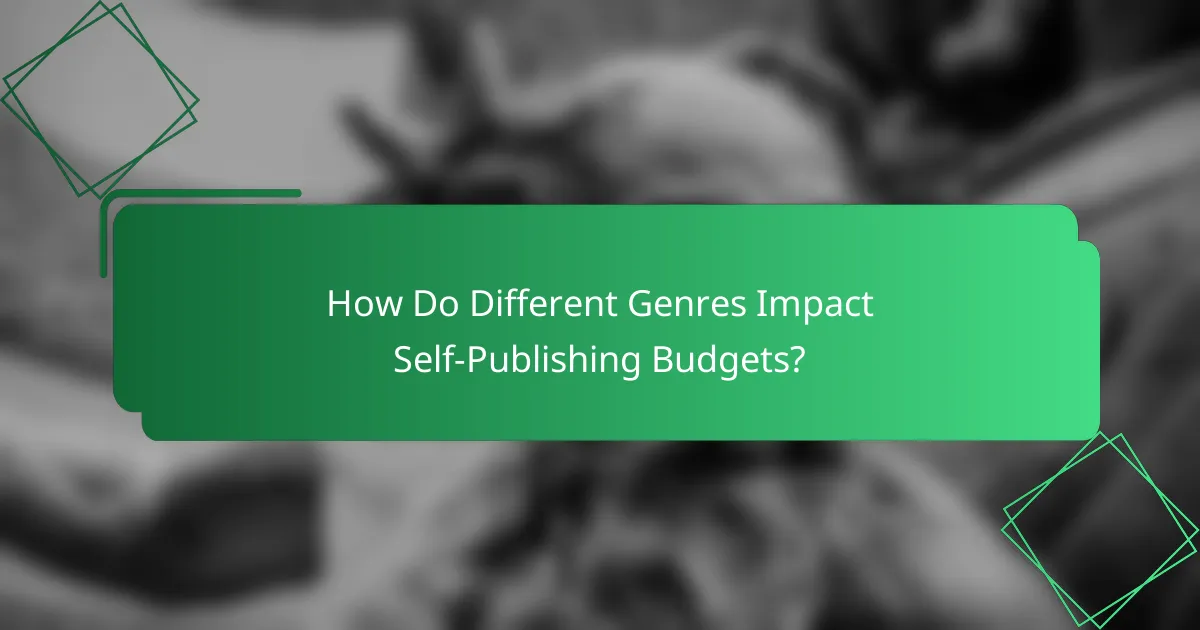
How Do Different Genres Impact Self-Publishing Budgets?
Different genres can significantly affect self-publishing budgets due to varying production and marketing costs. Fiction often requires more investment in editing and cover design, while non-fiction may focus more on research and fact-checking expenses.
Fiction vs. non-fiction costs
Fiction typically incurs higher costs for professional editing, as narrative flow and character development are crucial. Authors may spend anywhere from a few hundred to several thousand dollars on editing services, depending on the manuscript’s length and complexity.
In contrast, non-fiction authors often allocate funds for research, fact-checking, and possibly hiring experts for accuracy. Costs can range from a few hundred dollars for basic editing to more substantial amounts if extensive research is involved.
Genre-specific marketing needs
Marketing strategies vary widely between fiction and non-fiction genres. Fiction authors often rely on social media campaigns, book trailers, and reader engagement through platforms like Goodreads, which can require a budget of several hundred to a few thousand dollars.
Non-fiction marketing may focus more on targeted advertising, partnerships with relevant organizations, and speaking engagements. This can lead to costs that vary significantly based on the niche, often requiring a budget that aligns with the author’s expertise and audience reach.

What Are the Benefits of Crowdfunding for Authors?
Crowdfunding offers authors a way to raise funds for their projects while engaging with potential readers. It allows writers to secure upfront capital without traditional loans or investments, making it an attractive option for those on a tight budget.
Access to upfront capital
Crowdfunding platforms enable authors to gather financial support from backers before their book is published. This upfront capital can cover costs such as editing, cover design, and marketing, which are essential for a successful launch. Many authors find that they can raise anywhere from a few hundred to several thousand dollars, depending on their audience and campaign strategy.
To maximize funding, authors should set clear goals and offer appealing rewards for different pledge levels. Common incentives include signed copies, exclusive content, or early access to the book. However, it’s crucial to ensure that the rewards are feasible and deliverable to avoid disappointing backers.
Build a reader community
Crowdfunding not only raises funds but also helps authors connect with their audience. By promoting their campaign, authors can attract potential readers who are interested in their work, fostering a sense of community around their writing. Engaging with backers through updates and feedback can create loyal supporters who are more likely to promote the book upon its release.
Authors should actively communicate with their backers during the crowdfunding process. Regular updates about the project’s progress and behind-the-scenes insights can enhance the connection. Additionally, leveraging social media to share the campaign can broaden reach and attract more supporters, turning initial backers into a dedicated readership.
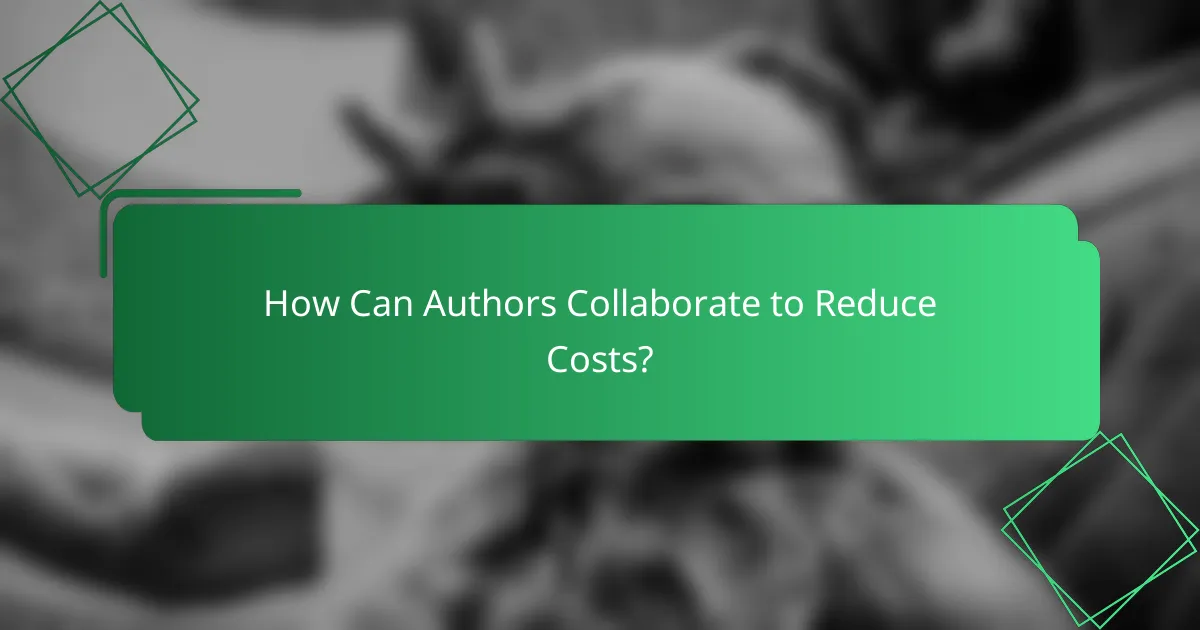
How Can Authors Collaborate to Reduce Costs?
Authors can significantly lower their self-publishing expenses by collaborating with other writers and professionals. This approach allows for shared resources, skills, and knowledge, ultimately leading to more efficient project completion and cost savings.
Partnering with Other Authors
Collaborating with fellow authors can lead to shared marketing efforts and reduced costs for services like editing and cover design. By pooling resources, authors can negotiate better rates with freelancers or even exchange services based on each other’s strengths.
For instance, if one author excels in graphic design while another is skilled in writing, they can trade services to create a professional cover and polished manuscript without incurring high costs. This mutual support fosters a sense of community and can enhance visibility for all involved.
Utilizing Online Communities
Online writing communities and forums can be invaluable for authors looking to cut costs. These platforms often provide access to free resources, advice, and opportunities for collaboration. Authors can find critique partners, beta readers, and even co-authors who share similar goals.
Engaging with these communities can also lead to group projects, such as anthologies, where multiple authors contribute stories. This not only spreads the financial burden but also expands each author’s audience through shared marketing efforts.
Sharing Resources and Tools
Authors can save money by sharing tools and resources like software, templates, and research materials. For example, a group of authors might invest in a single subscription to a writing software and share access, significantly reducing individual costs.
Additionally, creating a shared document repository for research materials or marketing strategies can streamline the writing process and reduce duplication of effort. This collaborative approach enhances productivity while keeping expenses low.
